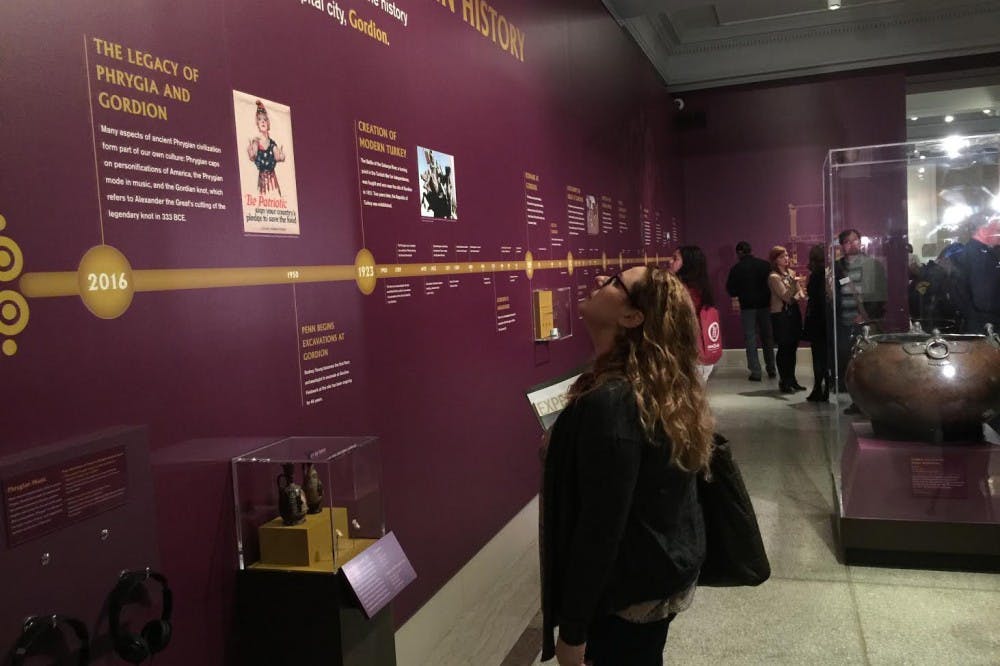The University of Pennsylvania Museum of Archaeology and Anthropology has undertaken a project to dispel a myth.
Sprawling through the right side of the museum for the next 10 months, visitors will be able to step back in time and explore the life and mystery of mythical ruler King Midas.
With the world premiere exhibit opening of "The Golden Age of King Midas" on Feb. 13, the Penn Museum takes visitors on a journey to almost 3,000 years ago. In famous mythical stories, King Midas is known for his “golden touch” — the power to transform things into gold. But in history, King Midas was the powerful ruler of the kingdom of Phrygia, which now lies in modern Turkey.
Penn Museum has been excavating at the Phrygian capital of Gordion for roughly 65 years. However, it was in 2012 that the museum began its negotiations with Turkey to decide what stories it will highlight in its exhibition as well as preparing its space in the museum. A total of 124 objects were brought in from overseas, all coming from Turkey except for one. All together, the exhibit showcases over 220 objects.
Kate Quinn, Director of Exhibitions and Public Programs at the Penn Museum, said that part of the challenge of putting the exhibit together was figuring out how to tell the stories of the ancient city of Gordion in a way that is accessible to visitors. Closely working with the exhibit’s curator Brian Rose, the museum’s staff talked to some visitors to find out how much they knew about Phrygia. Then they used a visitor’s survey analysis as a starting point for their storytelling of the history of ancient Turkey.
“We knew that people recognize Midas,” the exbibit’s Interpretive Planning Manager Jessica Bicknell explained. “So part of the goal was to introduce this culture through something that people recognize.”
Rose and his team flew to Turkey to choose from hundreds of artifacts for the exhibition. With these objects, Penn’s archeologists and anthropologists started the process of reconstructing the narrative of ancient Turkey from the perspective of the power, wealth and influence of the Phrygian kingdom of Midas.
“This is the only exhibit in North America, I think, that gives you the history of ancient Turkey,” Rose said. “It is also the first one to unravel the secrets of King Midas: who he was, what he did and the kind of empire that he ruled.”
Deputy Director of the Gordion Project Ayse Gursan-Salzmann, a Turkish native who received her Ph.D. in anthropology from Penn in 1992, also pointed to the exclusivity of the exhibition. As a leader in the excavation project, Gursan-Salzmann has worked on the ground in Gordion for 20 years.
"[The exhibit] really has introduced people to objects that have left Turkey for the first time,” Gursan-Salzmann said.
Penn Museum will display the artifacts for 10 months and then return them to the seven different Turkish museums from which they were borrowed.

Some items discovered in the tomb of King Midas’s father Gordios include bronze bowls of various sizes. Because their rarity draws visitors’ attention, these bowls command presence in the exhibit. The royal family as well as the affluent enjoyed feasts with foods such barbecue lamb and lentil stew, although most Phrygians ate bread. At its Pepper Mill Cafe, the museum is serving Turkish-inspired meals, such as chickpea fritters with curry and herbs. Also being served is a mildly-spicy chicken skewer marinated with yogurt. On its third floor, the museum set up a Turkish-style space called Kervansaray with wall-to-wall carpets, throw rugs and low seats.
Turkish women’s attire, such as long dresses, present an aura of elegance and ornament with their extravagant details and soft draping. During the press preview of the exhibit, a replica of a Phrygian gown flown in from a Turkish fashion institute specialized in old culture was modeled by graduate student Jess Holler.
The majority of Phrygians were farmers, but others worked in food preparation and in textile production. With a connection to the Greek language, Phrygians spoke an Indo-European language. However, with their brief surviving text mostly inscribed on pottery, scientists have yet to figure out how to completely read Phrygians’ messages.
Ibrahim Onaral, president of the Turkish American Friendship Society of the United States, noted that Turkey is located in a very archeologically-rich land between Europe and Asia and that the King Midas exhibit is a huge opportunity for publicity for the country. He also mentioned that the government of Turkey could have refused to allow such items of historical importance to leave their country.
“The Turkish government deserves a lot credit for letting the Museum have all these artifacts,” Onaral said.
Rose stressed the long and hard work that the museum has invested over the years not only in its project with the museum exhibit but also in its archeological studies in general.
“In a sense, this exhibit is the performance of our archeological research,” he said. “It’s a commitment no other university has made in terms of archaeology.”
In putting historical pieces of the Gordion site together, one of the museum’s main objectives was to increase public awareness on the kingdom of Phrygia and its ruler.
“We hope that people will walk away knowing a little bit more about the real King Midas, Phrygia and this time period,” Bicknell said.









